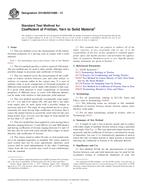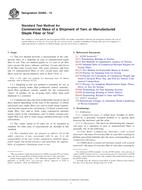Potrebujeme váš súhlas na využitie jednotlivých dát, aby sa vám okrem iného mohli ukazovať informácie týkajúce sa vašich záujmov. Súhlas udelíte kliknutím na tlačidlo „OK“.
ASTM D3108/D3108M-13
Standard Test Method for Coefficient of Friction, Yarn to Solid Material
Automaticky preložený názov:
Štandardná skúšobná metóda pre koeficient trenia, priadze, ktorá má pevný materiál
NORMA vydaná dňa 1.7.2013
Informácie o norme:
Označenie normy: ASTM D3108/D3108M-13
Poznámka: NEPLATNÁ
Dátum vydania normy: 1.7.2013
Kód tovaru: NS-22512
Počet strán: 6
Približná hmotnosť: 18 g (0.04 libier)
Krajina: Americká technická norma
Kategória: Technické normy ASTM
Kategórie - podobné normy:
Anotácia textu normy ASTM D3108/D3108M-13 :
Keywords:
coefficient of friction, yarn, ICS Number Code 59.080.20 (Yarns)
Doplňujúce informácie
| Significance and Use | ||||||||||||
|
5.1 Test Method D3108 for the determination of kinetic friction between yarn and solid materials may be used for the acceptance testing of commercial shipments of yarn, but caution is advised since between laboratory precision is known to be poor. Comparative tests as directed in 5.1.1 may be advisable. 5.1.1 If there are differences or practical significance between reported test results for two laboratories (or more), comparative tests should be performed to determine if there is a statistical bias between them, using competent statistical assistance. As a minimum, test samples that are as homogenous as possible, drawn from the material from which the disparate test results were obtained, and randomly assigned in equal numbers to each laboratory for testing. The test results from the two laboratories should be compared using a statistical test for unpaired data, at a probability level chosen prior to the testing series. If a bias is found, either its cause must be found and corrected, or future test results for that material must be adjusted in consideration of the known bias. 5.2 The frictional properties of textile yarns and of machinery components such as yarn guides are of general interest and have many applications. Because the frictional properties of yarns will affect the performance and life of yarn guides, sewing and knitting needles, and other contact surfaces, the modifying effects of surface finishes and lubricants are of special interest. Frictional properties also affect the quality and performance properties of yarns and subsequently of products made from them. As a consequence, frictional properties are of interest in research, control, and product design. 5.3 It is stressed that there is no coefficient of friction for a single body such as a yarn or a surface. A coefficient of friction measures the interaction between two bodies or elements such as a yarn running over a surface. 5.4 Although this method lays down standardized conditions of test, nonstandard conditions may be used for research or diagnosis but should be reported as such. 5.5 This method covers determination of the mean friction over a specified length of yarn. 5.6 Additional information has been reported in the literature.3,4,5 |
||||||||||||
| 1. Scope | ||||||||||||
|
1.1 This test method covers the measurement of the kinetic frictional properties of a moving yarn in contact with a solid material. 1.2 This test method specifies a
relative speed of 100 m/min. The test method may be used at other
speeds, although with a possible change in precision and
coefficient of friction.
1.3 This test method covers the measurement of the coefficient of kinetic friction between yarn and solid surface or surfaces of constant radius in the contact area. If a yarn of uniform value is used, comparisons of frictional properties of different solid materials can be made with relation to that yarn. If a given solid material is used, comparisons of frictional properties of different yarns, or yarns with different finishes, can be made with relation to that particular solid material. 1.4 This test method specifically recommends wrap angles of 1.57, 3.14 and 6.28 radian (90, 180 and 360°), but other wrap angles may be used, again with a possible change in precision and level. The angle of wrap should not be so great, especially for yarns having high coefficients of friction, that it causes the output tension to exceed the yield value for the yarn being tested. Also, in every case the angle of wrap should not be less than 1.57 rad (90°). 1.5 This test method has been applied to yarns having linear densities ranging between 1.5 and 400 tex [14 and 3600 denier] and having coefficients of friction ranging between 0.1 and 1.0 but may also be used with yarns outside these ranges of linear densities and coefficients of friction. 1.6 The values stated in either SI units or inch-pound units are to be regarded separately as standard. The values stated in each system may not be exact equivalents; therefore, each system shall be used independently of the other. Combining values from the two systems may result in non-conformance with the standard. 1.7 This standard does not
purport to address all of the safety concerns, if any, associated
with its use. It is the responsibility of the user of this standard
to establish appropriate safety and health practices and determine
the applicability of regulatory limitations prior to use.
Standard Practice for Sampling Yarn for
Testing Standard Terminology Related to Yarns and
Fibers Standard Test Method for Linear Density
of Yarn (Yarn Number) by the Skein Method Standard Practice for Conditioning and
Testing Textiles Standard Test Method for Coefficient of
Friction, Yarn to Yarn Standard Terminology Relating to
Textiles |
Podobné normy:
Historická
1.6.2010
Historická
1.2.2012
Historická
1.3.2012
Historická
1.5.2011
Historická
1.7.2013
Historická
1.7.2013
Odporúčame:
EviZak - všetky zákony vrátane ich evidencie na jednom mieste
Poskytovanie aktuálnych informácií o legislatívnych predpisoch vyhlásených v Zbierke zákonov od roku 1945.
Aktualizácia 2x v mesiaci !
Chcete vedieť viac informácii ? Pozrite sa na túto stránku.



 ASTM D2256/D2256M-10..
ASTM D2256/D2256M-10.. ASTM D2257-98(2012)..
ASTM D2257-98(2012).. ASTM D2258-99(2012)..
ASTM D2258-99(2012).. ASTM D2259-02(2011)..
ASTM D2259-02(2011).. ASTM D2260-03(2013)..
ASTM D2260-03(2013).. ASTM D2494-13
ASTM D2494-13
 Cookies
Cookies
